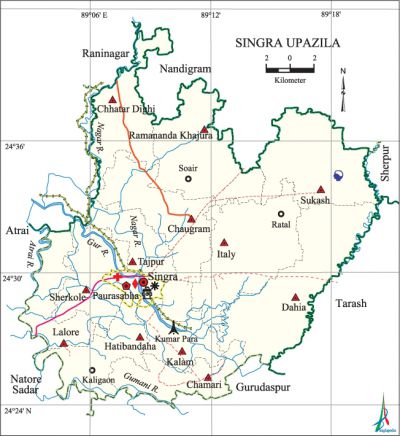Singra Upazila
Singra Upazila (natore district) area 528.46 sq km, located in between 24°24' and 24°41' north latitudes and in between 89°03' and 89°20' east longitudes. It is bounded by nandigram upazila on the north, gurudaspur upazila on the south, tarash and sherpur (bogra) upazilas on the east, natore sadar, atrai and raninagar' (Naogaon) upazilas on the west.
Population Total 320818; male 165673, female 155145; Muslim 289187, Hindu 30877, Buddhist 275, and others 478. Indigenous community such as santal belongs to this upazila.
Water bodies Main rivers: Gur, atrai, Gumani, nagar.
Administration Singra Thana, now an upazila, was formed in 1869. Singra Municipality was formed in 2003.
| Upazila | ||||||||
| Municipality | Union | Mouza | Village | Population | Density (per sq km) | Literacy rate (%) | ||
| Urban | Rural | Urban | Rural | |||||
|
1 |
12 |
446 |
431 |
22864 |
297954 |
607 |
47.9 |
35.8 |
| Municipality | ||||||||
|
Area (sq km) |
Ward |
Mahalla |
Population |
Density (per sq km) |
Literacy rate (%) | |||
|
12.22 |
9 |
26 |
22595 |
1809 |
48.0 | |||
| Upazila Town | ||||||||
|
Area (sq km) |
Mouza |
Population |
Density (per sq km) |
Literacy rate (%) | ||||
|
1.16 |
1 |
269 |
232 |
42.4 | ||||
| Union | ||||
| Name of union and GO code | Area (acre) | Population | Literacy rate (%) | |
| Male | Female | |||
|
Italy 47 |
16096 |
14519 |
13813 |
32.52 |
|
Kalam 55 |
5969 |
13063 |
12086 |
34.55 |
|
Chamari 12 |
7400 |
13710 |
12896 |
33.11 |
|
Chaugram 23 |
11505 |
9923 |
9209 |
40.10 |
|
Chhatar Dighi 15 |
9675 |
12862 |
11889 |
41.02 |
|
Tajpur 87 |
9935 |
6869 |
6440 |
39.60 |
|
Dahia 31 |
17795 |
13705 |
13060 |
27.89 |
|
Ramananda Khajura 71 |
14042 |
13523 |
12701 |
34.80 |
|
Lalore 63 |
7518 |
12509 |
11690 |
36.11 |
|
Sherkole 79 |
3152 |
5360 |
5037 |
43.10 |
|
Sukash 94 |
13549 |
15621 |
14667 |
35.42 |
|
Hatibandaha 39 |
8237 |
13671 |
12765 |
35.09 |
Source Bangladesh Population Census 2001, Bangladesh Bureau of Statistics.

Archaeological heritage and relics Temple of Sree Sree Radharaman, Sree Sree Narayan Bigraha Thakur' and Deb Bigraha (1890).
Historical events Since mid seventeenth century Singra area had been under the jurisdiction of Barabkabad 'Sarkar of' Suba Bangla, and the headquarters of the Chaugram Pargana was at Singra. In 1748 this region came under the zamindari of rani bhabani. Natore Circle was formed in 1914 consisting of Natore, baraigram and Singra.
Marks of the War of Liberation Mass grave 1 (Kumar Para).
Religious institutions Mosque 423, temple 76, church 2, tomb 4. Noted religious institutions: Singra Jami Mosque, Jamtali Mosque, tomb of Ghasipir at Dahia, temple of Sree Sree Radharaman, Sree Sree Narayan Bigraha Thakur and Deb Bigraha.
Literacy rate and educational institutions Average literacy 36.73%; male 41.84%, female 31.30%. Educational institutions: college 7, technical school 17, secondary school 53, primary school 200, madrasa 12. Noted educational institutions: Kalam Degree College, Bilhalti Trimohani Degree College (Dangapara), Rahmat Iqbal Degree College (Bomihal), Chaugram High School and College (1913), Singra Damdama School and College (1901), Lalore High School (1901), Kalam High School (1924), Ayesha Bashirul Dakhil Madrasa, Golak Para Dakhil Madrasa, Bhulbaria Alhaj Islamia Dakhil Madrasa.
Cultural organisations Library 2, club 14, cinema hall 3, theatre stage 1, women organisation 5, jatra party 1, playground 14.
Main sources of income Agriculture 79.79%, non-agricultural labourer 3%, industry 0.53%, commerce 7.99%, transport and communication 1.28%, service 2.97%, construction 0.43%, religious service 0.18%, rent and remittance 0.12% and others 3.71%.
Ownership of agricultural land Landowner 60.48%, landless 39.52%; agricultural landowner: urban 47.11% and rural 61.46%.
Main crops Paddy, wheat, maize, mustard, potato, garlic, onion, bamboo.
Extinct or nearly extinct crops Tobacco, sesame, jute.
Main fruits Mango, jackfruit, guava, date, watermelon.
Fisheries, dairies and poultries Fishery 14, dairy 41, poultry 106.
Communication facilities Pucca road 80 km, semi-pucca road 54 km, mud road 425 km; waterway 39 nautical miles.
Extinct or nearly extinct traditional transport Palanquin, horse carriage.
Noted manufactories Rice mill, flour mill, ice factory, biscuit factory, welding factory.
Cottage industries Goldsmith, blacksmith, potteries, brass and bell metal work, wood work, chatai making.
Hats, bazars and fairs Hats and bazars are 29, fairs 9, most noted of which are Singra Hat, Kaliganj Hat, Bildahar Hat, Jamtali Hat, Dahia Hat, Pakuria Hat, Durgapur Hat, Bandar Hat, Sherkole Hat, Tajpur Hat, Battalar Mela, Tisikhela Urs Mela and Durga Bisharjan (sacrifice) Mela on the bank of the river Nagar.
Main exports Rice, paddy, fish, date molasses, chatai, brass and bell metal utensils.
Access to electricity All the wards and unions of the upazila are under rural electrification net-work. However 20.81% of the dwelling households have access to electricity.
Sources of drinking water Tube-well 92.88%, tap 0.64%, pond 0.39% and others 6.09%.
Sanitation 19.53% (rural 16.58% and urban 59.73%) of dwelling households of the upazila use sanitary latrines and 70.22% (rural 73.22% and urban 29.38%) of dwelling households use non-sanitary latrines; 10.25% of households do not have latrine facilities.
Health centres Hospital 1, satellite clinic 5, family welfare centre 7, clinic 2.
NGO activities Operationally important NGOs are brac, proshika, asa, CARE. [MG Newaz]
References Bangladesh Population Census 2001, Bangladesh Bureau of Statistics; Cultural survey report of Singra Upazila 2007.
